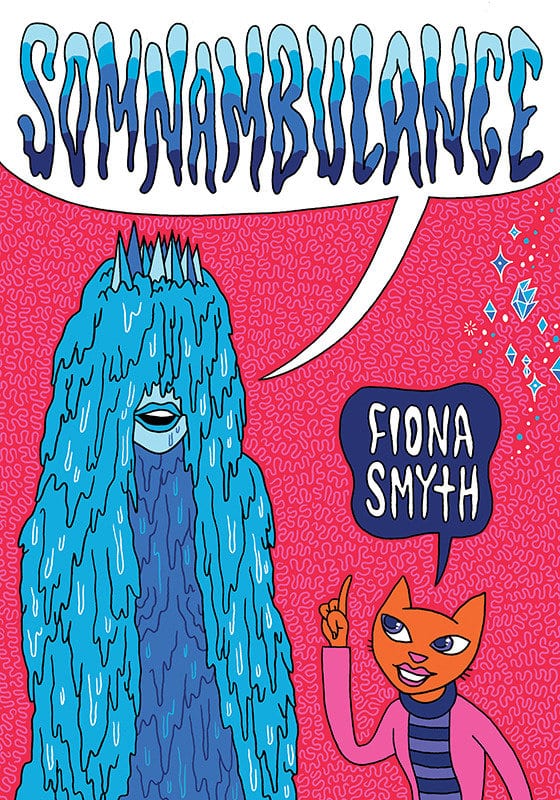
First let me admit that Robert Crumb’s erotic comics creep me out. I realize Robert Crumb wants to creep me out, that’s the point of Robert Crumb, he’s sexually creepy so of course his sexually explicit comics are going to be creepy too (though his word-for-word adaptation of The Book of Genesis is a wholesome, beautiful work of comics genius, not a fig-leaf of creepiness in all of that Garden of Eden nudity).
Phoebe Gloeckner creeps me out too—but in the opposite way. Though Crumb-influenced, Gloeckner doesn’t cartoon her own damaged desires but those of the damaging men around her. Her sexually explicit images document not just her abuse but the shame it made her feel and the process of overcoming both through drawing.
Given those double poles of creepiness, I’m surprised then by how uncreepy Fiona Smyth’s erotic comics are. Though equally explicit and often far more bizarre, they are infused with delight rather than shame. Unlike Gloeckner, Smyth documents pleasure, not exploitation. And though Crumb’s excesses suggest wanton freedom, they seem to mask his own kind of inversely expansive shame too. Smyth is simply having fun. As one of her drawings declares, “Why not embrace the deluge?”
Koyama Press has collected a decades-spanning retrospective of Smyth’s comics works. Somnambulance begins with half-page strips of inch-high panels from the mid-’80s and concludes with a ten-page sequence of full-page panels dated last year. While the 366 pages fully showcase the evolution of Smyth’s whirling production, according to the brief introduction by Canadian poet R. M. Vaughn, a complete collection would fill at least another volume or two.
Though the edition includes no table of contents, each strip and zine and mini-comic and solo show and serialized episode is identified and dated in the bottom margin of each page—with a generous range of unpublished work mixed in, too. The edition allows a few breaks in strict ordering, but the effect is overwhelmingly chronological, showing the evolutions of Smyth’s consistently energetic output.
The early ’90s receives the largest segment — over 100 pages — with major highlights from Vortex Comics and Drawn & Quarterly. The most recent decade is the briefest, though Smyth continues to produce monthly if not weekly art. Koyama Press could have included a biographical essay or timeline for newcomers (myself included), but instead let Smyth’s art stand for itself, overshadowing the circumstances of the artist who produced it.
The volume does include one non-Smyth page, a hand-drawn intro by Canadian comics artist Seth from 1991, preparing new readers to enter her “fully realized world” with “characters popping out of nowhere” who have “a complicated history that runs back thru years of paintings and mini-comics.” The statement is equally true almost three decades later—though repeated imagery and subject matter takes precedence over recurring characters. Still, it’s fun to follow the scattered installments as Juggs the Milkman and Dick the Detective give way to Gert the Mannequin—who later seems not a mannequin at all—as well as one of Smyth’s few lead male protagonists, Toad. Other characters are less namable, with hints of perhaps Smyth herself in a Catholic high schooler’s apparent memoir about fearing that God would impregnate her like the Virgin Mary.
(courtesy of Koyama Press)
But the volume is less about character and more about style. These are cartoons in the simplified and distorted sense, but Smyth is no minimalist. Her panels are packed with details, often purely abstract lines surrounding foregrounded figures posed in endless variations of impossible sexual positions. Though the images are almost always about sex, a slow study of each page reveals surprising nuance, with an unexpected attention to the non-sexual content—the swirls and cross-hatchings of the larger world. Smyth often patterns every centimeter of her panels, so that when an undrawn expanse of white appears, it juts from the page. “Somnambulance” refers to sleep walking, and though the volume title evokes Smyth’s “Nocturnal Emissions” series, it also suggests a stylistic approach, a kind of trance-like doodling. Though her images are crowded and hectic, they convey a slow calmness in their rendering—the deliberate, unhurried energy of an artist leaning over her artboard, filling it edge-to-edge with loving detail.
(courtesy of Koyama Press)
Smyth’s lines are also clean. Where Crumb obsessively pencils deeper and deeper into a figure’s anatomy, Smyth achieves her shapes with single, confident pen strokes. And since Crumb’s sexual creepiness is embodied in his style, Smyth’s conveys a more balanced sexuality. Her figures aren’t weighed down by their rendering. And where Crumb and Gloeckner disturbingly exaggerate genitals, Smyth’s array of breasts and penises often appear in delicate proportion to the rest of a figure’s equally fantastical body parts. Superhero comics of the same decade featured heroines with breasts larger than their heads and nipples barely contained by scanty, skin-tight costumes. Smyth’s fire-erupting vaginas seem paradoxically wholesome in comparison. Smyth also appreciates a range of body types. This is not Barbie Doll erotica, a fact made explicit by the “Heavy Girl Press Zine” excerpts, though the aesthetic is suggested throughout.This is not to say that Smyth is simply documenting the joys of sexuality. Her art contains plenty of the grotesque, too. Demonic figures appear as often as frolicking cartoon animals. But while Catholic guilt sometimes serves as a kind of plot point, it never prevails. The female protagonist of the lone bestiality story written by Patty Flowers feels a sudden “intense body repulsion I’d never experienced before” and then guilt “like I had sexually abused him”, but she and her dog Fluffy ultimately reconcile, “probably thinking the same thing: ‘wrong species.'” A Crumb story would never end with characters choosing not to have sex. And a Gloeckner would never allow those characters to escaped untraumatized.


